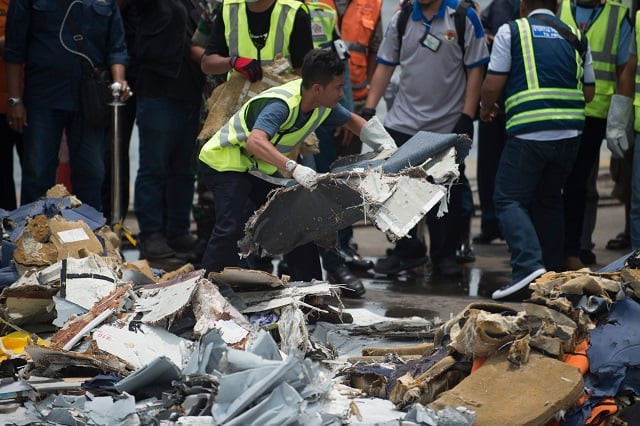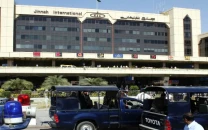Second black box from Indonesian Lion Air crash recovered
Discovery could be critical to explaining why a brand new plane fell out of the sky just after take-off

Officials transfer recovered debris from the ill-fated Lion Air flight JT 610 for further examination by Indonesia's National Transportation Safety Committee, at a port in Jakarta, on November 2, 2018. PHOTO:AFP
The Boeing 737 MAX vanished from radar about 13 minutes after departing Jakarta, slamming into the Java Sea moments after pilots had asked to return to the capital and killing all 189 people onboard.
The bright orange voice recorder was discovered early Monday about 10 metres from a flight data recorder that was located back in November, authorities said.
"It's broken into two pieces so hopefully it's still useful" to investigators, Haryo Satmiko, deputy head of Indonesia's National Transportation Safety Committee (NTSC), told AFP.
More human remains were also found near the voice recorder, he added, without giving details.
"This will really help the investigation... and could give some more answers on the cause" of the crash, said Jakarta-based aviation analyst Dudi Sudibyo.
The doomed airliner's flight data recorder supplied information about its speed, altitude and direction before it plunged into the sea on October 29.
"But (the data recorder) does not show how the flight crew's decisions were made or discussed in those final moments," Stephen Wright, an aviation expert at Leeds University, told AFP.
A preliminary crash report from Indonesia's transport safety agency suggested that the pilots of Flight 610 struggled to control the plane's anti-stall system just before the accident.
The agency also found that the Lion Air jet should have been grounded over a recurrent technical problem before its fatal journey, and it criticised the budget carrier's poor safety culture.
But it did not pinpoint a definitive cause of the crash and a final report is not likely to come before later this year.
Despite the name, black boxes are usually bright orange with reflective stripes, and all commercial planes are obliged to have them on board.
They're built to survive at vast depths and in extreme heat, and are fitted with a beacon which can emit a signal for one month.
Black box data helps explain nearly 90 percent of all crashes, according to aviation experts.
Authorities called off the grim task of identifying victims of the crash in November, with only 125 people named after tests on human remains that filled some 200 body bags.
"We're thankful and grateful that they have found the CVR, but it's not enough," said Evi Samsul Komar, whose son and nephew were on the fatal flight.
"There are still many passengers unaccounted for."
Despite a spotty safety record and an avalanche of complaints over shoddy service, the carrier's parent Lion Air Group -- which also operates five other airlines -- has become Southeast Asia's biggest airline group by fleet size in less than 20 years of operation.
Indonesia's aviation safety record has improved since its airlines, including national carrier Garuda, were subject to years-long bans from US and European airspace for safety violations. But the country still recorded more than three dozen fatal accidents over the past 15 years.
Nearly 30 relatives of the Lion Air crash victims are suing Boeing, alleging faults in the plane led to the deaths.
The MAX variant of the 737 is one of the world's newest and most advanced commercial passenger jets.
After investigators said the doomed aircraft had problems with its airspeed indicator and angle of attack (AoA) sensors, Boeing issued a special bulletin telling operators what to do when they face the same situation.
An AoA sensor provides data about the angle at which air passes over the wings and tells pilots how much lift a plane is getting. The information can be critical in preventing an aircraft from stalling.
The Lion Air 737's flight data recorder showed that pilots had repeatedly tried to correct its nose from pointing down, possibly after erroneous data from AoA sensors was fed into a system that automatically adjusts some of its movements.
The preliminary crash report stopped short of making any recommendations to Boeing, but the American aviation giant has come under fire for possible glitches on the 737 MAX, which entered service in 2017.



















COMMENTS
Comments are moderated and generally will be posted if they are on-topic and not abusive.
For more information, please see our Comments FAQ